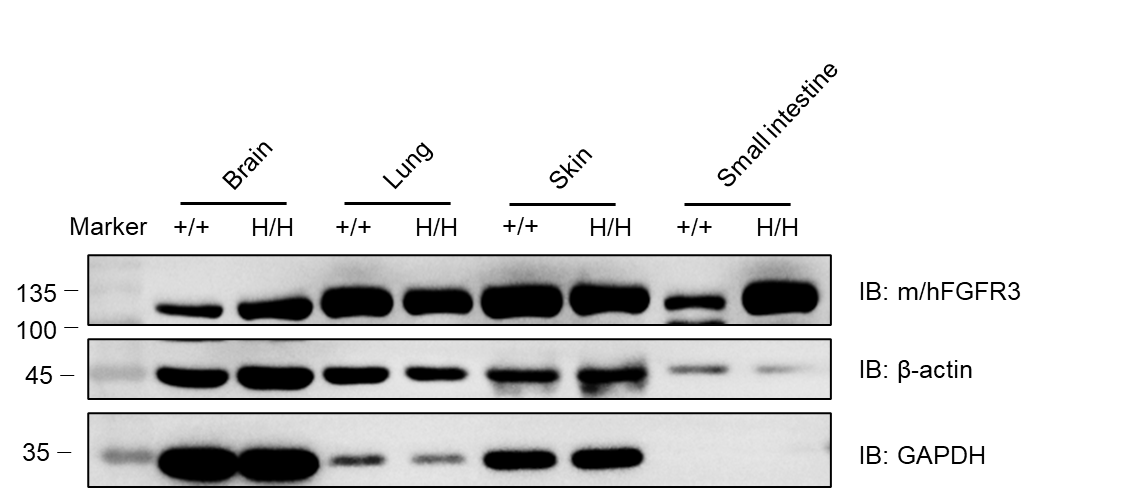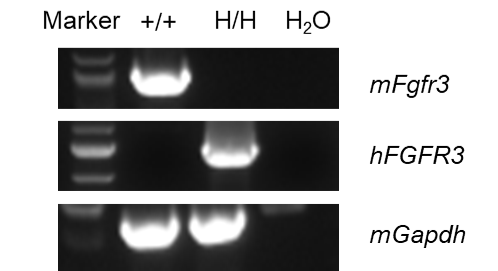Description
- Fibroblast growth factors (FGFs) are polypeptide growth factors involved in a variety of activities including mitogenesis, angiogenesis, and wound healing (PMID: 1847508). The human FGF receptor family, a subfamily of receptor tyrosine kinases (RTKs), comprises of four family members (FGFR1, FGFR2, FGFR3, and FGFR4).
- FGFR3 is a type I transmembrane tyrosine kinase receptor that binds FGF ligands along with heparin or heparin sulfate proteoglycans as co-factors. A segment of the membrane proximal Ig-like domain can be encoded by two different exons resulting in (IIIb) or (IIIc) isoforms. The IIIb or IIIc isoforms recognize FGF-1, -2, -4, -8b, -8e, -8f, -9 and -17b.
- The exons 2-18 of mouse Fgfr3 gene that encode signal peptide, extracellular domain, transmembrane domain, cytoplasmic region and 3’UTR were replaced by human counterparts in B-hFGFR3 mice plus. The promoter and 5’UTR region of the mouse gene were retained. The human FGFR3 expression was driven by endogenous mouse Fgfr3 promoter, while mouse Fgfr3 gene transcription and translation will be disrupted.
- FGFR3 were detectable in brain, lung, skin and small intestine in wild-type mice and homozygous B-hFGFR3 mice plus. The antibody was cross-reactive between human and mouse.
- Mouse Fgfr3 mRNA was detectable in wild-type mice. Human FGFR3 mRNA was detectable only homozygous B-hFGFR3 mice plus but not in wild-type mice.
- B-hFGFR3 mice plus can be used to evaluate the in vivo efficacy of antibody drugs and small molecule drugs targeting FGFR3.
Targeting strategy
Gene targeting strategy for B-hFGFR3 mice plus. The exons 2-18 of mouse Fgfr3 gene that encode signal peptide, extracellular domain, transmembrane domain, cytoplasmic region and 3’UTR were replaced by human counterparts in B-hFGFR3 mice plus. The promoter and 5’UTR region of the mouse gene were retained. The human FGFR3 expression was driven by endogenous mouse Fgfr3 promoter, while mouse Fgfr3 gene transcription and translation will be disrupted.
Protein expression analysis
Western blot analysis of FGFR3 protein expression in homozygous B-hFGFR3 mice plus. Various tissue lysates were collected from wild-type C57BL/6JNifdc mice(+/+) and homozygous B-hFGFR3 mice plus (H/H), and then analyzed by western blot with anti-FGFR3 antibody (Abcam, ab133644). 40 μg total proteins were loaded for western blotting analysis. FGFR3 were detectable in brain, lung, skin and small intestine in wild-type mice and homozygous B-hFGFR3 mice plus. The antibody was cross-reactive between human and mouse.
(This suggests that human and mouse expression profiles may not be fully conserved in the small intestinal tissue.)
mRNA expression analysis
Strain specific analysis of FGFR3 mRNA expression in wild-type C57BL/6JNifdc mice and B-hFGFR3 mice plus by RT-PCR. Brain RNA were isolated from wildtype C57BL/6JNifdc (+/+) and homozygous B-hFGFR3 mice plus (H/H), then cDNA libraries were synthesized by reverse transcription, followed by PCR with mouse or human FGFR3 primers. Mouse Fgfr3 mRNA was detectable in wild-type mice. Human FGFR3 mRNA was detectable only homozygous B-hFGFR3 mice plus but not in wild-type mice.
* When publishing results obtained using this animal model, please acknowledge the source as follows: The animal model [B-hFGFR3 mice plus] (Cat# 113743) was purchased from Biocytogen.


